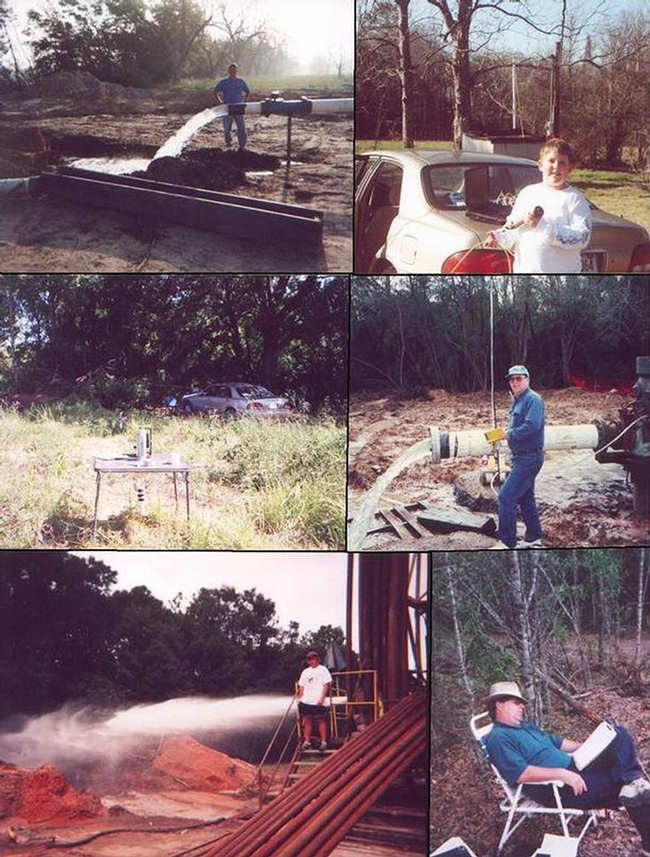Aquifer Testing
Sounds interesting but what is an aquifer test. Aquifer testing is a planned procedure where a well is pumped and the response to the pumping is measured by monitoring the water level in both the pumped well and adjacent wells as the well is pumped and after it is shut down. The water level data is then analyzed to establish aquifer parameters such as transmissivity, coefficient of storage and hydraulic conductivity. Properly run and analyzed, aquifer tests can provide a wealth of information for use in managing your groundwater resource.
OAI presents this collection of photos with explanations of what you see. Beginning in the photo at the top right and moving counter clockwise:

Top Right: This photo was made during a 48-hour constant rate test for a Choctaw County water system. The test utilized an adjacent private well as an observation well and a data logger, held by my son Sam, to collect water levels as the test was run. Of interest in the photo is the white PVC piping sticking up behind and to the left of Sam's head. The aquifer being tested had enough artesian pressure to cause the water level in the private supply well to rise ~ 8 feet above ground. The PVC column was added to the exisiting well to account for this pressure. A second "flowing well" was also monitored during the test. This aquifer test supported the development of a 2-well single aquifer wellfield at this location. Using the private well saved the system the expense of an observation well for the test and, more importantly, eliminated an artificial penetration of the overlying clay that protects the aquifer from contamination from surface sources.
Top Left: Ahh the smell of fresh groundwater in the morning. This is a photo of a 1,500 gpm discharge for a south Mobile County system. The photo was taken toward the end of the required 24/6 test. In a 24/6 test, the well is pumped at design capacity for 24 hours after drawdown in the production well stabilizes then it is cranked up to 150% of design capacity and pumped unitl it stabilizes at the rate for an additional 6 hours. This well was permitted at the 1,000 gpm rate.
Middle Left: This was a neat test in that it used multiple observation wells screened in different aquifers. The test was run to assist in permitting a south Mobile County system's new well. The two observation wells included one, seen by the card table, screened in a shallow aquifer and the other, seen just above and to the left of the thermos, screened in the aquifer tapped by the production well. Both observation wells were monitored with data loggers and electric tapes. Data from the test was used to evaluate the hydraulic conductivity of the confining unit separating the two aquifers. Aproximately 48 hours of testing was completed at this site. That's Dan back in the shade (it gets hot in Mobile County) with his nephew Michael who assisted on this test. Michael is now a PE in Florida.
Lower Left: This is a photo of a "tight" well being developed. Our son Daniel is seen in the photo as the well is blowing. This deep well was drilled based on hydrogeology worked up by OAI that identified a deep untested aquifer in the area. The exploratory bore for this project was drilled at the time of the terrosit attacks of September 11, 2001. The aquifer tapped by the test well is the deepest freshwater aquifer in Mobile County. Daniel, gradutated from Troy in May 2008, served as an Army nurse including six months in Afghanastan, earned his Masters and Phd as a nurse practioner and lives with his wife and two childrn in Tennessee.
Lower Right: A co-hort snapped this shot of Dan getting a little shut-eye after ~30 hours of testing. OAI runs data loggers on all our tests and we collect critical measurements using electric tapes as back-up to the data loggers in the event they fail. We know the importance of obtaining quality data and don't want to miss any of it. OAI has completed aquifer tests up to 30 days in length with up to five observation well.
Middle Right: This is a photo of a 1,245 gpm test for a Baldwin County system whose new well was drilled based on OAI's subsurface mapping and siting recommendation. Over 1.4 million gallons of water were produced during this test. An intersting thing noted on this test was a slight increase in water level in the observation well as a locomotive passed typical of confined aquifers. The observation well installed during the permitting process is now equipped with a data logger to continuously track water level over time. OAI received a grant from the Mobile Bay National Estuary Program to monitor water levels in four obervation wells monitoing aquifers tapped by 13 public water supply wells. Water level monitoring is a critical but often overlooked part of a system's management plan. Call today to learn more about the importance of water level monitoring program for your wells.